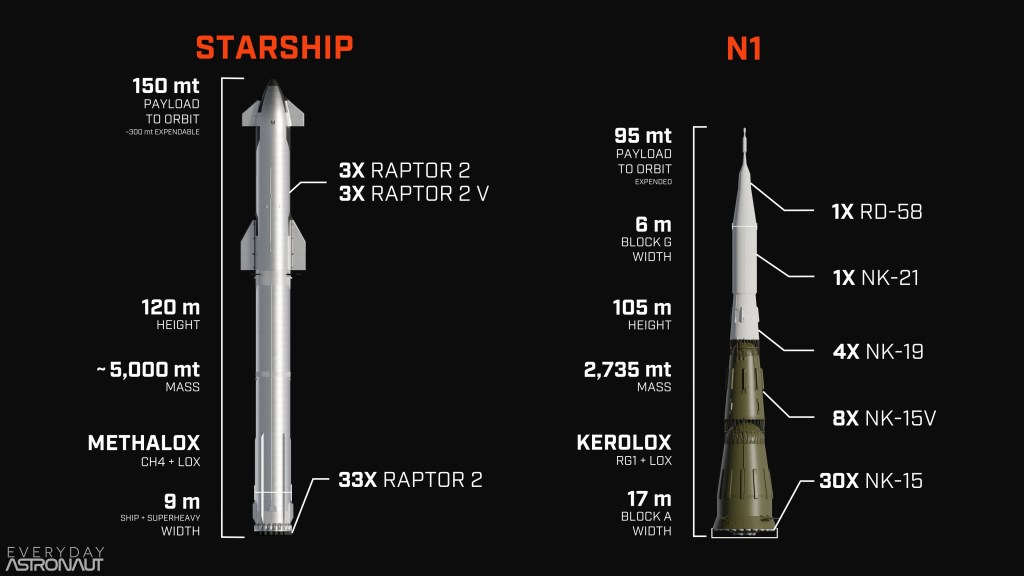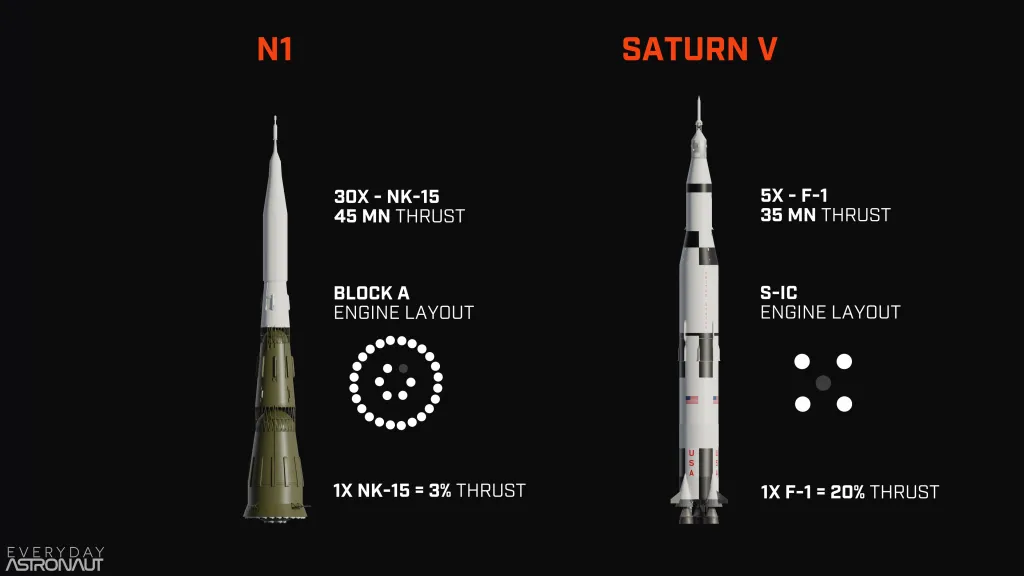On April 20, 2023, SpaceX’s Starship and its Super Heavy booster broke the record set by the Soviet Union’s N1 rocket, becoming the world’s most powerful rocket. Despite the differences in time and geography, these two rockets share striking similarities. In this article, we will explore the parallels between the N1 and Starship, analyze their designs, and examine the reasons behind their engine choices. Additionally, we will discuss their respective capabilities and the philosophies that guided their development.
Let’s begin by comparing the N1 and Starship side by side. The N1 was the Soviet Union’s ambitious attempt at a moon rocket, aiming to rival the United States’ Saturn V. It was an enormous rocket, measuring 17 meters in width at the base, tapering up to six meters in width for the upper stages, and towering at an impressive height of 105 meters. When fully fueled, it massed 2,735 metric tonnes.
In contrast, Starship is even taller, standing at 120 meters, with a width of 9 meters for both stages. However, what sets Starship apart is its weight when fully fueled, which reaches approximately 5,000 metric tonnes—nearly double that of the N1. Starship’s design enables it to carry up to 150 tonnes into low-Earth orbit, making it the most capable rocket ever built.
The N1 employed kerolox, a combination of RG-1 and liquid oxygen, as its propellants. Starship utilizes methalox—a mixture of liquid methane and liquid oxygen. Another distinction lies in the number of stages, with the N1 having a minimum of three stages, but for lunar missions, it utilized up to five stages, similar to the Saturn V. In contrast, Starship is a two-stage rocket, comprising the Super Heavy booster stage and the Starship upper stage, both of which are designed to be fully reusable.

Perhaps the most prominent similarity between the N1 and Starship lies in the number of engines they employ. The N1’s Block A first stage featured 30 NK-15 engines, while the Starship’s Super Heavy booster boasts 33 Raptor 2 engines. The N1 had additional engines on subsequent stages, whereas Starship relies on a combination of three sea-level Raptors and three vacuum-optimized Raptors on its upper stage. However, it’s important to note that these engine configurations for Starship are subject to change as the rocket is still in development.
The NK-15 engines on the N1 Block A Booster utilized an oxygen-rich closed cycle, a technology the Soviets had mastered in the early 1960s. These engines produced 1,526 kN of thrust and had a specific impulse of 297 seconds at sea level, with a mass of approximately 1,250 kg. The Raptor 2 engines on Starship produce 2,255 kN of thrust and have a specific impulse of 327 seconds at sea level while massing only 1,600 kg. Consequently, the Raptor 2 engine has a superior thrust-to-weight ratio of approximately 144:1 compared to the NK-15’s 122:1 ratio. This means that not only is the Raptor 2 more efficient and produces more thrust per kilogram—a crucial advantage.

Philosophies
One common question people have is why these rockets have so many engines. Doesn’t more engines mean more potential points of failure and a more complicated system? While it’s true that more engines have the potential for more failure points, there are several advantages to having many smaller engines.
One advantage is that the loss of an engine has less impact on total thrust levels with many smaller engines compared to fewer larger engines. For example, the N1 rocket had 30 engines producing 45 MN of thrust, while the Saturn V had 35 MN of thrust from just five engines. If one engine failed on the Saturn V, it would result in a 20% loss of thrust, potentially jeopardizing the mission. In contrast, losing one engine out of the N1’s 30 engines would only result in a 3% loss of thrust, which is within acceptable margins to continue the mission.

Additionally, a larger number of engines can provide more robustness in the event of an engine failure. Although more engines increase the chances of failure, having multiple engines allows the rocket to continue operating even if one engine fails. SpaceX’s Falcon 9 rocket, which uses nine smaller engines, has demonstrated this reliability, with only two engine shutdowns during ascent that did not result in mission failure. Moreover, SpaceX’s Falcon Heavy, equipped with 27 engines, has maintained a flawless record of mission success.
To enhance reliability, each engine can be enclosed in its own blast containment shield, preventing a catastrophic failure from affecting neighboring engines. SpaceX has implemented improvements in blast containment shields for their Super Heavy boosters to enhance safety.
Aside from operational advantages, many small engines offer cost benefits and easier handling. The economies of scale come into play when producing a larger number of smaller engines, allowing for quicker depreciation of research and development costs. SpaceX has already achieved significant cost reductions in engine production, with the Raptor 2 engines costing less than $1,000,000 each, compared to the F-1 engine on the Saturn V, which cost approximately $115,000,000 per engine in today’s currency. Smaller engines are also less prone to combustion instability issues that larger engines can face.
Furthermore, the smaller size of engines makes them easier to handle, test, install, and transport. Higher production rates and more frequent testing provide more opportunities to identify flaws and make improvements in manufacturing. With several smaller engines, there is more testing time available to refine the engine design and ensure reliability.
Although the initial flights of Starship showcased some engine issues, SpaceX has produced over 300 Raptor engines and implemented a more rigorous testing regime, aiming to achieve outstanding reliability. The decision to fly early versions of the rocket, despite lower success probabilities, is driven by the pursuit of learning and improving the system, similar to the approach taken by the Soviet Union with the N1.
Trial By Flying
The Soviet Union had limited options with the N1 rocket due to its inability to conduct thorough static fire tests. They couldn’t even test fire each individual engine, as the NK-15 engines used pyrotechnics to open valves, rendering them single-use. Instead, they opted to test only one in every six engines (many places online say one in every three, which is incorrect) to identify general production errors. Consequently, the engines used in the N1 flights were not test-fired before launch. This compelled the Soviets to rely on launch tests as the only means to evaluate the N1’s performance.

Similarly, SpaceX chose a similar philosophy of iterative testing with Starship, despite conducting engine tests and static fire tests. They believe that testing, even if it fails, provides valuable data and insights. Rather than trying to solve all the complexities of flying, landing, and reusing the world’s largest rocket in one go, SpaceX adopts a step-by-step approach, learning from each test.
The first integrated test flight of Starship aimed to clear the launch pad without catastrophic failure, although it did result in violent concrete ejections that damaged parts of the complex. Nevertheless, the flight validated various aspects, including passing through Max Q, testing the heat shield tiles under strong wind shears, and confirming the functionality of systems and equipment. SpaceX gained real-world experience and identified areas for improvement, such as the flight termination system.
The question arises: Why did both SpaceX and the Soviet Union opt for this iterative design process instead of thoroughly engineering and testing each part for high success rates on the first flight? The answer lies in the differences in their contexts. NASA’s SLS rocket, for example, underwent extensive testing and engineering over 12 years, aiming for flawless performance to avoid cancellation. The SLS achieved a high degree of success on its first launch, but at a significantly higher cost.
On the other hand, Starship began its engine development in 2016 and became a full-fledged project at SpaceX around the same time. It took seven years to conduct the first integrated flight test, and the rocket is still far from operational. However, the iterative process allows for rapid production, evolution, and improvement of Starship, positioning it for operational status in the future.
SpaceX follows a “build fast, test, break stuff, iterate, fly, blow stuff up, learn from it, repeat” approach, akin to the Soviet Union’s philosophy. While the N1 faced a different fate, Starship’s future remains uncertain. However, considering its potential for operational capabilities, continued improvement, and adaptability, Starship is poised to carve its own path and achieve success in the years to come.
Will Starship Suffer The Same Fate?
The failure of the N1 rocket cannot be attributed solely to the number of engines it had. While the number of engines played a role, the root cause of failure was primarily the quality of the NK-15 engines. These engines were relatively new, untested, and prone to failure. The lack of testing for both the engines and the full first stage, coupled with the use of a primitive computer system called KORD to manage the numerous engines, created a recipe for disaster.

Thrust differential, the mode of steering used by the N1, also posed challenges. It required precise throttle commands and resulted in more time spent in transients as the engines throttled up and down. If an engine shut down, the KORD computer had to shut down the opposite engine to maintain equal thrust. This meant that the N1 could only afford to lose two engines since each shutdown required the opposite engine to be shut down as well, leaving little room for error.
In contrast, Starship’s Super Heavy booster primarily steers through the center 13 engines, which are capable of gimballing. Gimballing allows the engines to swivel and provide pitch, yaw, and roll control. The Raptor engines used in Starship have an impressive gimbal range of 15 degrees and can make rapid adjustments using electromechanical servo thrust vector controls. This means that if an engine fails, Starship can maintain control by adjusting the gimbal angles, without needing to shut down opposing engine pairs.
Despite the challenges faced by the N1, it is believed that they would have eventually resolved the issues and improved the rocket’s performance. The N1-F, the next iteration of the N1, was expected to feature upgraded and more reliable engines, the NK-33.
Starship benefits from over 50 years of advancements in computer and aerospace technologies. Modern computers allow the engines to detect anomalies and shut down before catastrophic failure occurs. Furthermore, SpaceX has a solid revenue stream from being a leading launch provider and rapidly expanding its Starlink internet service. They are investing significant resources into Starship and have the goal of mass-producing the rockets. SpaceX’s track record of achieving once thought-impossible feats and its commitment to innovation make them less susceptible to running out of funds or facing untimely setbacks.
SpaceX is already developing multiple facilities to scale up Starship production, and there are several vehicles near completion. While they currently lack a working launch pad, it is reasonable to believe that SpaceX will find a solution. It’s important to note that these assessments are not biased but based on SpaceX’s demonstrated ability to overcome challenges and accomplish remarkable feats in a relatively short period.
Summary
In summary, while the N1 faced significant difficulties, Starship has the advantage of technological advancements, financial stability, and a proven track record of pushing boundaries. SpaceX’s commitment to iterative design, economies of scale, and reusability positions Starship for success and the potential to revolutionize space transportation.





I would contend that SpaceX intends to Develop Starship and Super Heavy for full reusability at some time in the future. I consider it misleading to state that it is designed for full reusability.
I disagree. Every public statement and design choice has been made with full reusability as the primary goal. Starship has a heat shield, it previously had landing legs during the re-entry & landing tests. The booster has “catch points” to be caught by the tower during a landing phase for re-use. Respectfully, you couldn’t be more wrong.
https://en.wikipedia.org/wiki/SpaceX_Starship
Mars Colonial Transporter -> Interplanetary Transport System -> BFR -> Starship
From the beginning, the point of this huge rocket was full reusability. Why else go through the trouble of adding legs even in early prototypes? Why else develop a catching system so early in development?
Now of course not all will have these features, considering they will serve different purposes. We’re already aware of multiple Starship variants, but most of their focus so far was the fully reusable one, as it’s the most important in the lineup. It’s also the hardest to get done, so it’s worth beginning with that – the rest will be easy by comparison, once they will have a lot of lessons learned.
Excellent piece
A key factor you neglected to mention wrt the SpaceX risk accepting highly iterative design approach vs the NASA test to perfection approach is the ability to trim the “safety margin” of the entire system back to a reasonable “necessary and sufficient” level vs. what is almost certainly an “excessive” level. This applies to almost any product domain, but is especially important for an orbital class rocket because mass that is NOT in the vehicle is mass that can be allocated to revenue generating payload. The SpaceX approach provides many opportunities to pare excess mass out of the rocket into money making payload mass to orbit while the NASA way locks in excess design margins that will hinder operational efficiency for its entire lifecycle.
The “test to perfection” approach is not necessarily NASAs. NASA pioneered the highly iterative design approach back during the early days of NASA, and they have reembraced it recently, actively encouraging it with contract awardees.
Great information for the public to use in support of or not supporting N.A.S.A. !
I support Space x based on the success it exhibits by the approach it uses !
Space is exciting for an 83 y.o. to watch !
This was a great read, thank you. I can’t wait to see starship fly and wonder how space flight would have changed had the N-1 succeeded
Phrasing here needs a correction, perhaps by removing the “not only” and moving the “is” to after “Raptor 2”.
“This means that not only is the Raptor 2 more efficient and produces more thrust per kilogram—a crucial advantage.”